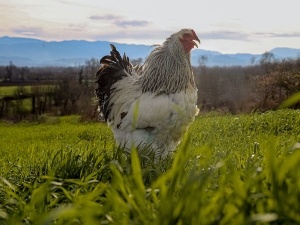
Any changes in how your chicken looks, whether this is a big or a small change, will be concerning to any chicken raiser. A chicken with green skin is quite alarming indeed.
This article looks into why your chicken’s skin is green
Table of Contents
Why is my chicken’s skin green?
It is common for chickens to have either white, yellow, or black skin, but green skin is quite unusual, here is why this may be happening with your bird:
Bruising:
One of the simplest reasons why your chicken’s skin may be going green is that the bird’s skin is bruised.
Unlike humans, who develop bruises that look red, purple, or black, your chickens will develop bruises that are green.
Your bird may have sustained a bruise while being pecked by other members of the flock, if it pecked itself, if it was attacked by your domestic pets, or if it was attacked by wild animals like raccoons, bobcats, or hawks.
What to do:
Treating the bird’s bruise and figuring out how the bird was bruised are both important.
If the bird is going about its day as normal, then the bird will likely recover on its own with no issues, if the bird seems to be in some sort of distress then you’d need to intervene
You’d first need to get the bird into a room or area where it can recover, create a chicken hospital using a pet carrier or a dog crate and add a soft material as flooring. Pine shavings work well.
Avoid using something that the bird’s talons can become stuck on like a raggedy towel.
Keeping the bird isolated will keep the bird from suffering any more injuries.
If there is bleeding in the area stop the bleeding using a gauze, towel, or paper towel and then clean the injuries.
Also, give the bird its own food and water while it is recovering to keep it from having to go far for food and water
Deep muscle disease:
If your bird is not bruised then the other reason why your bird may have green skin is that the bird has deep muscle disease, this is also called deep pectoral myopathy.
This happens because of a restriction of blood, in the breast fillet and tender, when the bird flaps its wings excessively.
When chickens flap their wings the tender and breast grows in size by up to 20 percent because of the added blood flow in the area.
However, if the tender and the breast can’t expand as much as they need to, because they are trapped between the sternum and the tough membrane, then pressure will be exerted onto the tender and breast themselves.
This added pressure restricts blood supply to the muscles. The lack of blood flow in the area creates an oxygen deficiency and the tissue and cells in the area start to die causing damage in the area.
The damage will initially cause the area to go red and then the area can start to become green as it turns into a bruise.
What to do:
This isn’t a threat to the health of your bird but it may be unappealing to you if you choose to eat the bird.
You can try to avoid this by keeping your bird from flapping its wings excessively.
If you enjoyed this article then you may also be interested in other bird related articles. Here are some articles that you may be interested in: Why Is My Chicken’s Skin Yellow?, Why Is My Chickens Face White, Chicken Has Lump Under Eye, Chicken Swollen Under Beak, Why Is My Chicken’s Skin Red?, Red Skin On Chicken Head, Why Is My Chickens Face Red?, Why Does My Chickens Face Change Color?, Chicken Pale Around Eyes

